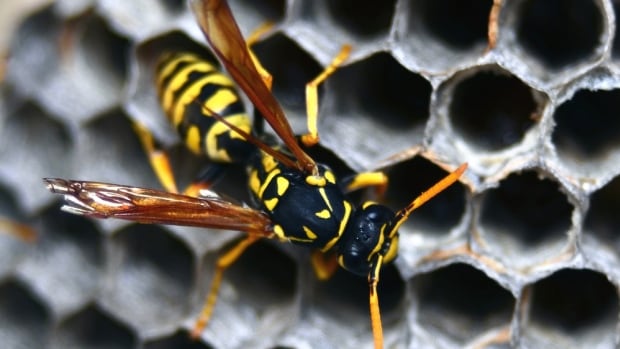Pest control technician JS Ouellette says this hot, dry summer has been good for business, with 25 to 40 calls per day to remove wasp nests — roughly four times the typical call volume.
“I am just parked and people will come up and be like, ‘Hey, do you deal with wasps? I have some,'” said Ouellette. “It’s just crazy right now.”
He believes the busier than usual season is due to an abundance of aphids — a result of a wet spring and hot summer — that wasps feed on.
Plus, wasps tend to become more active as summer rolls on.
“They tend to be a little nastier towards the end of the season, when the queens start leaving the nest and they know they are going to die,” said Ouellette, who works for The Pest Control Guy.

CBC News caught up with Ouellette at a Calgary home in the northwest community of Ranchlands, where the homeowner says his tenants noticed a steady stream of wasps near their front step.
“They moved in and the first phone call was, ‘We have wasps at our front door’,” said Darcy McGregor, the homeowner.
He said when he lifted the concrete slab, he couldn’t see a nest but noticed they were going underground.
“They’re hidden, and I just know you can run into lots of trouble if you don’t look after them. So I called a professional,” said McGregor.
Busier than usual?
Entomologist John Swann says rather than a spike in wasp numbers, he believes the increased wasp reports are due to more people enjoying the warmer weather and then spotting the pests.
He says aphids are just one source of food, but not enough to create a population boom.
He says a typical nest may have a few hundred wasps — and the larger ones could hold a few thousand.

At this time of year, the flying pests are more noticeable because people are often outside enjoying food or drink. Swann says the wasps are also interested in the food as they try to beef up their colonies before the first major frost.
He calls them the raccoons of the insect world, willing to eat almost anything to survive.
“They’re hungry because their colonies are huge and they’ve got to feed all the babies,” said Swann.
But, he notes, if this hot weather continues into October, the size of each nest will continue to grow, and then they could become a really big problem.
“So could we end up with bigger populations this fall? You betcha,” said Swann.
Alarm pheromone
How to avoid getting stung? First, try not to swat them.
Swann says when wasps feel under threat, they release an alarm pheromone, which will not only attract more wasps from the same nest but other nests, too.
“You’ll get basically swarmed because they’ll think, ‘Oh, it’s a bear or some predator in our home,’ and you’ll get more than one species out to sting you,” said Swann.
He says if you start to get swarmed, it’s important to isolate yourself — in a car or your home.
Swann says his dog and son got swarmed in Castle Provincial Park last year. He believes his dog started chewing on a stick that had been plugging a ground nest, setting off a nasty attack.
This extended heat wave means wasps are able to reproduce more quickly – and if the trend continues, we can expect to see new stinging species arrive in our province.
So he yelled at his son to run to the car with their dog, an Airedale, which he noted has a double coat that likely helped with some protection.
“He had so many wasps crawling, trying to sting him, so he had an even bigger beak than normal, a sting or two, I think, around the bottom, and one or two on the belly.”
Ouellette says it’s tough, but the best tactic is to try to stand still and then, generally, they won’t bother you.
In fact, despite the higher call volume, he says he has yet to be stung.
“I don’t like to be stung,” Ouellette said with a chuckle.







